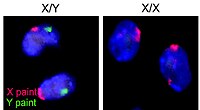| Part of a series on |
| Sex |
|---|
 |
| Biological terms |
| Sexual reproduction |
| Sexuality |
| Sexual system |
Sex is the biological trait that determines whether a sexually reproducing organism produces male or female gametes.[1][2][3][4][5] During sexual reproduction, a male and a female gamete fuse to form a zygote, which develops into an offspring that inherits traits from each parent. By convention, organisms that produce smaller, more mobile gametes (spermatozoa, sperm) are called male, while organisms that produce larger, non-mobile gametes (ova, often called egg cells) are called female.[6] An organism that produces both types of gamete is hermaphrodite.[3][7]
In non-hermaphroditic species, the sex of an individual is determined through one of several biological sex-determination systems. Most mammalian species have the XY sex-determination system, where the male usually carries an X and a Y chromosome (XY), and the female usually carries two X chromosomes (XX). Other chromosomal sex-determination systems in animals include the ZW system in birds, and the XO system in some insects.[8] Various environmental systems include temperature-dependent sex determination in reptiles and crustaceans.[9]
The male and female of a species may be physically alike (sexual monomorphism) or have physical differences (sexual dimorphism). In sexually dimorphic species, including most birds and mammals, the sex of an individual is usually identified through observation of that individual's sexual characteristics. Sexual selection or mate choice can accelerate the evolution of differences between the sexes.
The terms male and female typically do not apply in sexually undifferentiated species in which the individuals are isomorphic (look the same) and the gametes are isogamous (indistinguishable in size and shape), such as the green alga Ulva lactuca. Some kinds of functional differences between individuals, such as in fungi,[10] may be referred to as mating types.[11]
- ^ Stevenson A, Waite M (2011). "Sex". Concise Oxford English Dictionary: Book & CD-ROM Set. OUP Oxford. p. 1302. ISBN 978-0-19-960110-3. Retrieved 23 March 2018.
Sex: Either of the two main categories (male and female) into which humans and most other living things are divided on the basis of their reproductive functions. The fact of belonging to one of these categories. The group of all members of either sex.
- ^ Mills A (1 January 2018). "Sex and Reproduction". Biology of Sex. University of Toronto Press. pp. 43–45. ISBN 978-1-4875-9337-7. Retrieved 3 October 2023.
- ^ a b Purves WK, Sadava DE, Orians GH, Heller HC (2000). Life: The Science of Biology. Macmillan. p. 736. ISBN 978-0-7167-3873-2. Retrieved 23 March 2018.
A single body can function as both male and female. Sexual reproduction requires both male and female haploid gametes. In most species, these gametes are produced by individuals that are either male or female. Species that have male and female members are called dioecious (from the Greek for 'two houses'). In some species, a single individual may possess both female and male reproductive systems. Such species are called monoecious ("one house") or hermaphroditic.
- ^ De Loof A (31 January 2018). "Only two sex forms but multiple gender variants: How to explain?". Communicative & Integrative Biology. 11 (1): e1427399. doi:10.1080/19420889.2018.1427399. ISSN 1942-0889. PMC 5824932. PMID 29497472.
- ^ Goymann W, Brumm H, Kappeler PM (February 2023). "Biological sex is binary, even though there is a rainbow of sex roles: Denying biological sex is anthropocentric and promotes species chauvinism". BioEssays. 45 (2). doi:10.1002/bies.202200173. PMID 36543364. Retrieved 23 November 2024.
- ^ Kokko H, Jennions M (2012). "Sex differences in parental care". In Royle NJ, Smiseth PT, Kölliker M (eds.). The Evolution of Parental Care. Oxford University Press. p. 103. ISBN 978-0-19-969257-6.
The answer is that there is an agreement by convention: individuals producing the smaller of the two gamete types – sperm or pollen – are males, and those producing larger gametes – eggs or ovules – are females.
- ^ Avise JC (2011). "Two sexes in one". Hermaphroditism: A Primer on the Biology, Ecology, and Evolution of Dual Sexuality. Columbia University Press. pp. 1–7. ISBN 978-0-231-52715-6. Retrieved 18 September 2020.
- ^ Blackmon H, Ross L, Bachtrog D (January 2017). "Sex Determination, Sex Chromosomes, and Karyotype Evolution in Insects". The Journal of Heredity. 108 (1): 78–93. doi:10.1093/jhered/esw047. ISSN 0022-1503. PMC 6281344. PMID 27543823.
- ^ Hake L, O'Connor C (2008). "Genetic Mechanisms of Sex Determination | Learn Science at Scitable". Nature Education. 1 (1): 25. Archived from the original on 19 August 2017. Retrieved 13 April 2021.
- ^ Moore D, Robson JD, Trinci AP (2020). 21st Century guidebook to fungi (2 ed.). Cambridge University Press. pp. 211–228. ISBN 978-1-108-74568-0.
- ^ Kumar R, Meena M, Swapnil P (2019). "Anisogamy". In Vonk J, Shackelford T (eds.). Encyclopedia of Animal Cognition and Behavior. Cham: Springer International Publishing. pp. 1–5. doi:10.1007/978-3-319-47829-6_340-1. ISBN 978-3-319-47829-6.
Anisogamy can be defined as a mode of sexual reproduction in which fusing gametes, formed by participating parents, are dissimilar in size.